This article needs additional citations for verification .(July 2023) |
Salterio is the Italian, Spanish, and Portuguese term for either of two types of zither: the hammered dulcimer or psaltery.
This article needs additional citations for verification .(July 2023) |
Salterio is the Italian, Spanish, and Portuguese term for either of two types of zither: the hammered dulcimer or psaltery.
'Salterio' / 'saltério' is used in Italian and Spanish where both 'psaltery' and 'dulcimer' are used in Spanish, 'psaltérion' and 'tympanon' in French, 'psalterium' in Latin. There has always been cross-over between the various terms, and it is only in the last 100 years that scholars have tried to distinguish between them, proposing that a 'psaltery' is plucked while a 'dulcimer' is hit, and that both belong to a generic 'zither' family (distinct from specific instruments called 'zither' by their players); but this usage is an abstraction and has no basis in the traditional use of these names: there are plenty of illustrations where psalteries are hit and traditions where dulcimers are plucked. The point is rather that a distinct type evolved from about 1500 in which the strings were placed in different planes, presumably to make it easier to distinguish between them when they are hit with a hammer, but after that they were still plucked in many playing traditions.
Paul Gifford and Karl-Heinz Schickhaus have researched the salterio in 18th century Italy; there are instruments with up to eight strings per course (i.e. 8 strings tuned to the same note and played all together, like a 12-string guitar or the middle and upper notes of a piano), made in places like Venice, Florence, Brescia, Milan, and Triente[ citation needed ], and signed by ten different makers. Instruments and tuning diagrams show up to five bridges and fully chromatic tuning. They were used in upper-class circles for composed music like sinfonia and sonata. A salterio was bought for the Ospedale della Pietà when Antonio Vivaldi was working there; it cost more than a cheap violin, less than an expensive one. Some early 20th century writers suggest that the dulcimer in Italy was called salterio tedesco ("German psaltery"), but it is clear from Bonanni's Gabinetto Armonico that the normal word is simply salterio and that his illustration called salterio tedesco is of a German beggar girl who played one in the streets of Rome.
Pablo Minguet y Yrol's Reglas y advertencias ... (Madrid 1752) shows a salterio-player playing a dance tune from written music; and in the opera Los amantes chasqueados from 1779, the soprano soloist Maria Guerrero played a salterio on stage while singing: she was evidently highly competent, if not a virtuoso. An instrument in Brussels is identified as coming from the Canary Islands and having been made in Barcelona in 1779 [ citation needed ].
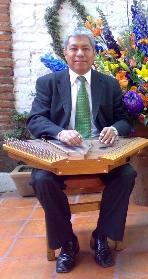

The salterio, with origins in the 16th century psaltery, is still occasionally played in live performances. Mexican psaltery has a trapezoidal form, is manufactured with wood, and is double and triple stringed. On the top board, five bridges are placed in order to seat stretched metal strings across from side to side. The strings are plucked with a metal pick adjusted on the index finger of each hand. [1]
There are salterios of various sizes, up to one meter long, with tessitura of tenor, soprano and requinto. The salterio requinto has 90 strings in 3 course, with a range from Si4 to Fa#9. The salterio tenor has more than 100 strings in 3-4 course order, with a range from Si3 to Fa#8.
Rogério Budasz has published a beautiful facsimile of Antonio Vieira dos Santos manuscript from about 1820 Cifras de música para saltério, together with a transcription, analysis and bibliography ( ISBN 85-7335-078-4).

The classical guitar, also known as Spanish guitar, is a member of the guitar family used in classical music and other styles. An acoustic wooden string instrument with strings made of gut or nylon, it is a precursor of the modern steel-string acoustic and electric guitars, both of which use metal strings. Classical guitars derive from instruments such as the lute, the vihuela, the gittern, which evolved into the Renaissance guitar and into the 17th and 18th-century baroque guitar. Today's modern classical guitar was established by the late designs of the 19th-century Spanish luthier, Antonio Torres Jurado.
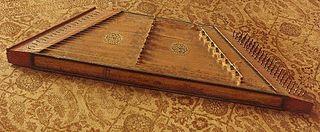
The word dulcimer refers to two families of musical string instruments.

The hammered dulcimer is a percussion-stringed instrument which consists of strings typically stretched over a trapezoidal resonant sound board. The hammered dulcimer is set before the musician, who in more traditional styles may sit cross-legged on the floor, or in a more modern style may stand or sit at a wooden support with legs. The player holds a small spoon-shaped mallet hammer in each hand to strike the strings. The Graeco-Roman word dulcimer derives from the Latin dulcis (sweet) and the Greek melos (song). The dulcimer, in which the strings are beaten with small hammers, originated from the psaltery, in which the strings are plucked.

In musical instrument classification, string instruments or chordophones, are musical instruments that produce sound from vibrating strings when a performer plays or sounds the strings in some manner.

Zithers are a class of stringed instruments. In modern terminology, it is more specifically an instrument consisting of many strings stretched across a thin, flat body, the topic of this article.

A psaltery is a fretboard-less box zither and is considered the archetype of the zither and dulcimer. Plucked keyboard instruments such as the harpsichord were also inspired by it. Its resonance box is usually trapezoidal, rectangular or in the form of a "pig's head" and often richly decorated.

The gusli is the oldest East Slavic multi-string plucked instrument, belonging to the zither family, due to its strings being parallel to its resonance board. Its roots lie in Veliky Novgorod in Novgorodian Republic. It has its relatives in Europe and throughout the world: kantele in Finland, kannel in Estonia, kanklės in Lithuania, kokles in Latvia, Zither in Germany, citera in the Czech Republic, and psalterium in France. Furthermore, the kanun has been found in Arabic countries, and the autoharp, in the United States. It is also related to such ancient instruments as Chinese gu zheng, which has a thousand-year history, and its Japanese relative koto. A stringed musical instrument called guslim is listed as one of the Me in ancient Sumer.

The Appalachian dulcimer is a fretted string instrument of the zither family, typically with three or four strings, originally played in the Appalachian region of the United States. The body extends the length of the fingerboard, and its fretting is generally diatonic.

The trapezoidal yangqin is a Chinese hammered dulcimer, likely derived from the Iranian santur or the European dulcimer. It used to be written with the characters 洋琴, but over time the first character changed to 揚, which means "acclaimed". It is also spelled yang ch'in. Hammered dulcimers of various types are now very popular not only in China, but also Eastern Europe, the Middle East, India, Iran, and Pakistan. The instruments are also sometimes known by the names "santoor" and "cymbalom". This instrument had an influence on the Thai classical instrument, known as Khim (ขิม).
The term requinto is used in both Spanish and Portuguese to mean a smaller, higher-pitched version of another instrument. Thus, there are requinto guitars, drums, and several wind instruments.

A tiple, is a plucked typically 12-string chordophone of the guitar family. A tiple player is called a tiplista. The first mention of the tiple comes from musicologist Pablo Minguet e Irol in 1752. Although many variations of the instrument exist, the tiple is mostly associated with Colombia, and is considered the national instrument. The Puerto Rican version characteristically has fewer strings, as do variants from Cuba, Mallorca, and elsewhere among countries of Hispanic origin.

The Bajo sexto is a Mexican string instrument from the guitar family with 12 strings in six double courses.

The bowed psaltery is a type of psaltery or zither that is played with a bow. In contrast with the centuries-old plucked psaltery, the bowed psaltery appears to be a 20th-century invention.
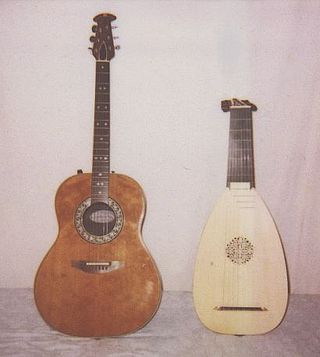
Plucked string instruments are a subcategory of string instruments that are played by plucking the strings. Plucking is a way of pulling and releasing the string in such a way as to give it an impulse that causes the string to vibrate. Plucking can be done with either a finger or a plectrum.
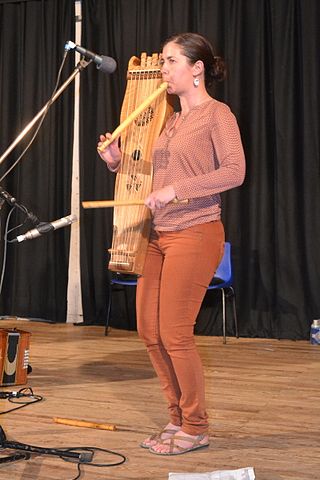
The string drum or Tambourin de Béarn is a long rectangular box zither beaten with a mallet. It is paired with a one-handed flute with three finger holes, similar to a pipe and tabor. It has also been called tambourin de Gascogne, tambourin à cordes in Catalan, Pyrenean string drum, ttun-ttun in Basque, salmo in Spanish, and chicotén in Aragonese. It was known in the middle ages as the choron or chorus.
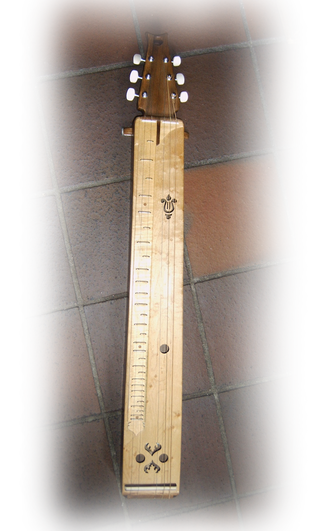
The épinette des Vosges is a traditional plucked-string instrument of the zither family, whose use was confined to two areas in the Vosges mountains of France approximately 50 km apart: around Val-d'Ajol and around Gérardmer.
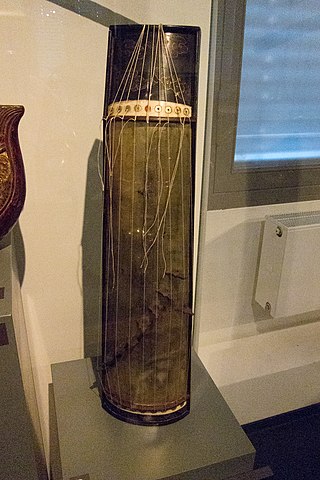
The box zither is a class of stringed instrument in the form of a trapezoid-shaped or rectangular, hollow box. The strings of the box zither are either struck with light hammers or plucked. Among the most popular plucked box zithers are the Arab qānūn and its various derivatives, including the harpsichord.

The psalterion is a stringed, plucked instrument, an ancient Greek harp. Psalterion was a general word for harps in the latter part of the 4th century B.C. It meant "plucking instrument".